
News
The Ultimate Guide to 13 Amp vs. 32 Amp Hot Tubs: Which One Is Right for You?
The honest truth
We are going to be very honest about the pros and cons in this article and much of it is going to against what you have probably been told in other hot tub shops or online. There is some good reasons for that (money), which we will explain! We would advise a careful read as there is some important things to understand.
When choosing a hot tub, one of the most important factors to consider is the electrical supply required to power it. Hot tubs typically come in two primary electrical configurations: 13 amp and 32 amp. Understanding the differences between these two options can help you make an informed decision that best suits your needs and lifestyle. In this blog post, we’ll break down the key differences between 13 amp and 32 amp hot tubs, including their installation requirements, performance, and suitability for various users.
These hot tubs generally have a single two-speed pump and a 2 kW heater. This is to limit the amount of power they can consume.
What Is a 13 Amp Hot Tub?
A 13 amp hot tub is often referred to as a “plug-and-play” model. As the name suggests, these hot tubs are designed to be plugged into a standard household electrical outlet, much like any other appliance.
There are several things to tackle early on here:
There are very few truly “plug and play” hot tubs on the market, the vast majority have been mis-represented! A true plug and play hot tub will leave the factory with the plug and cable already attached and this will not be added on by the retailer. If your retailer is adding on the plug, it’s simple, the manufacturer did not design this spa to be plugged into a standard 3 pin outlet and it is not permissable for the product to be modified to such. We have never seen a single set of manufacturer instructions that state a plug is to be added. They are designed to be hardwired in to a dedicated supply.
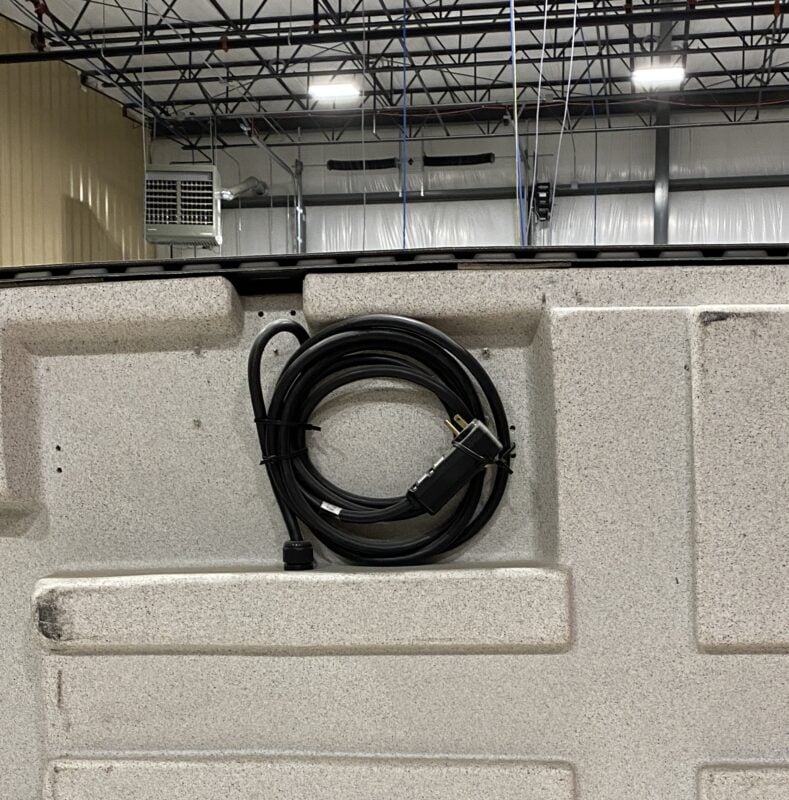
So why do retailers do it? Theres two simple answers to that, lack of knowledge and wanting to sell hot tubs. There are no formal qualifications needed to either sell hot tubs or install them, therefore there are many people out there who simply do not know, that what they are doing is wrong. Secondly, hot tubs that supposedly do not need any special electrics, sell much easier than those that do. It’s in the interest of the retailer to tell you that a model is plug and play (with them adding on the plug themselves), that way they sell more hot tubs and make more money.
Whats the issue? Firstly there is the legal one, the laws and directives being broken by adding a plug at the point of installation are:
Health & Safety at Work Act 1974 (HASAWA)
General Products Safety Regulations (GPSR): 2005
Plug & Sockets etc (Safety) Regulations: 1994
Electrical Equipment (Safety) Regulations: 2016
Electrical Wiring Regulations (BS 7671): 2018.
Any other issues? Yes! The biggest one is safety, across several areas:
- When a true plug & play spa is sold it should be provided with a built in RCD which is a safety device to protect against electric shock. When sold without, the hot tub could in theory be plugged into a non RCD protected socket, exposing the hot tubs users to a potentially fatal shock. Whereas a hot tub that is hard wired by a professional and register electrician will always be on a protected circuit.
- Many of the hot tubs we see being installed by other hot tub retailers and subsequent install photos posted on Facebook, show that not only are they adding a plug, they are using the wrong cable. Instead of using the correct cable that is suitable for use in an outdoor environment, they are using the cheapest white PVC cable possible. This cable is designed for rewiring the bed side lamp and thats about it. Your beloved pet could chew through it in about two seconds and it is not designed to withstand UV degradation.
- Overloading of the circuit. Many true plug and plays and those modified to be so, are plugged into sockets that are part of a circuit that provides power to multiple devices at one time. This can lead to both nuisance RCD tripping of the houses electrics and also can present a potential fire hazard.
- Why is it a hazard? A standard socket can supply around about 3kw max, but it is absolutely not designed to do this continuously. In fact it’s a recommendation from most electricians that anything which has the potential to draw 2kw or more, is situated on its own dedicated supply that is not shared with any other appliance. Most plug and plays sit on or slightly over that 2kw threshold. They are often left plugged in for months or even years at a time and this overloads a supply that was never designed for this. In some instances it can be a whole lot sooner that you experience issues.
The images below are all from a plug and play hot tub overheating the plug itself and the socket. These images are
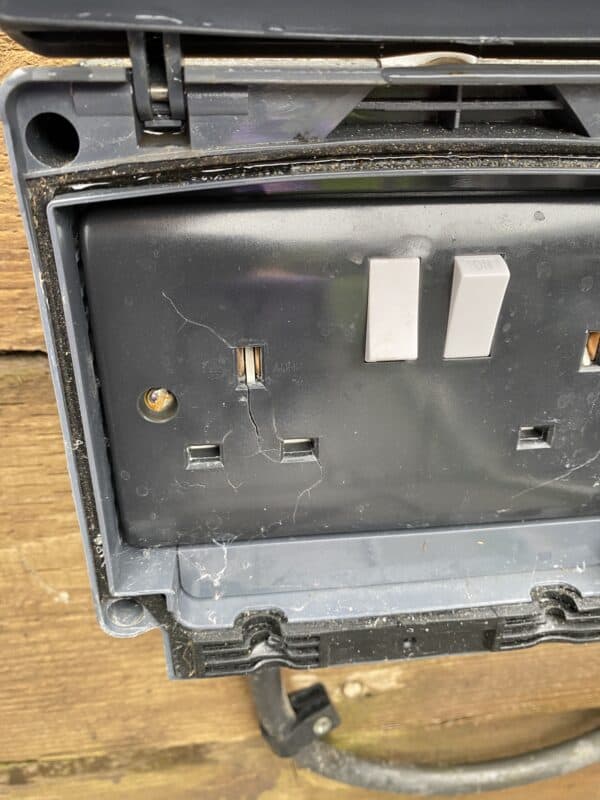
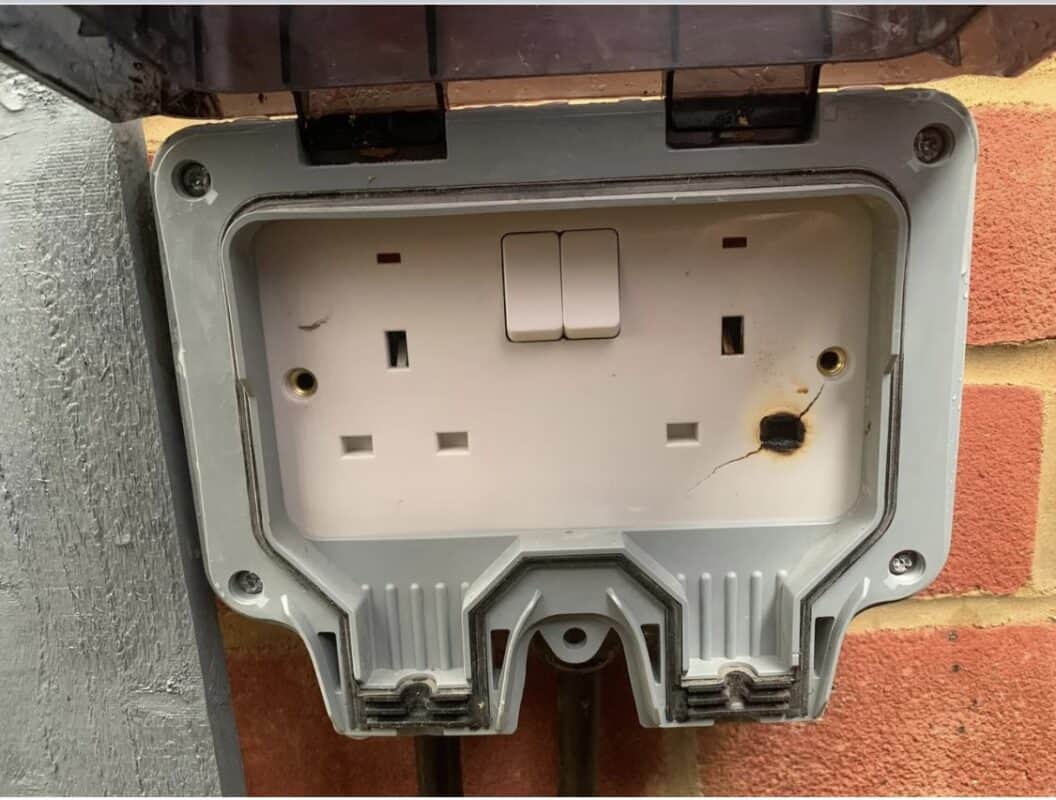
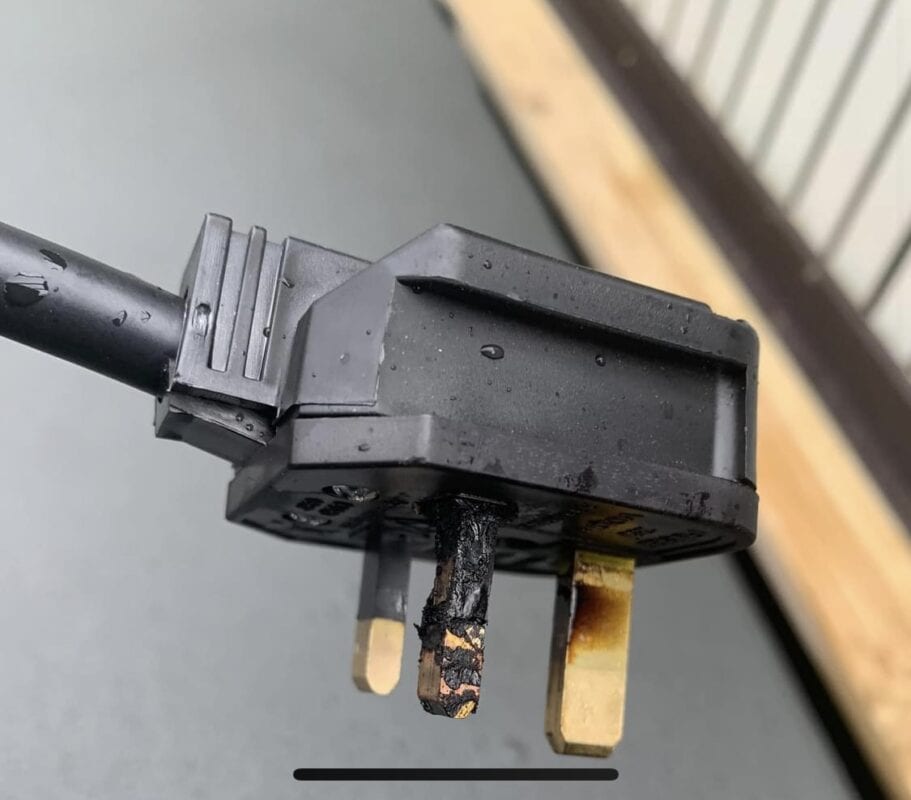
Ok, so it just sounds like I need a seperate supply for the how tub, job done right? Yes, we’re nearly there! Nearly any major supplier of 13 amp hot tubs now suggest that as a minimum, the hot tub is given its own dedicated 16 amp circuit that is not shared. An example of a dedicated circuit, if you are unsure, would be your electric shower. It has its own supply and breaker, which is located in your consumer unit/ fuse board. However, its now also largely accepted that a standard 3 pin UK plug is probably not the right tool for the job and either a commando type plug is used or it is directly wired into a rotary isolator switch like a 32 amp.
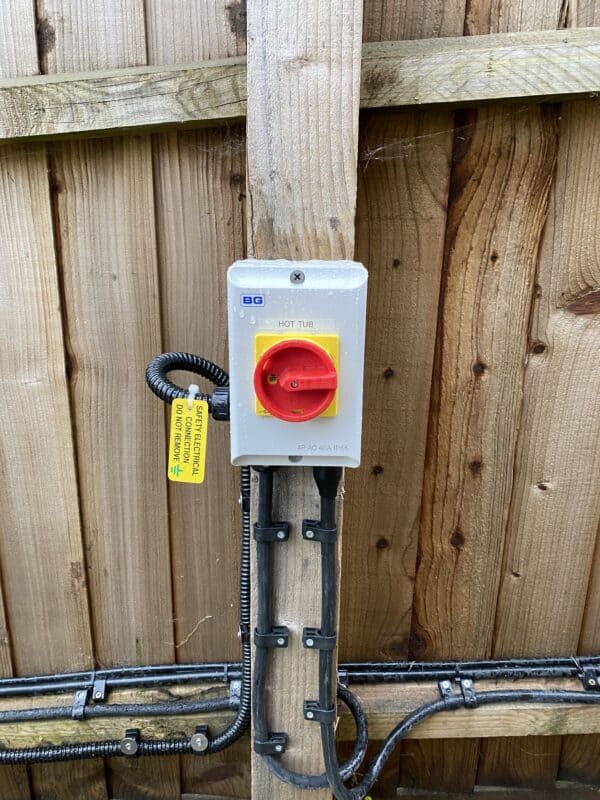

So what if I buy a dedicated, installed at the factory plug and play hot tub? Its probably best to speak to a qualified electrician, but our advise and that of those more knowledgable than us, would be that its still best off on its own dedicated circuit and there could also be a benefit to hardwiring it still. The fact it came with a plug still does not get round the fact that drawing 2 kW plus, on a consistent basis can cause issues when used with a standard socket and particularly on a shared circuit.
There are a couple of tubs out there that have been fitted with smaller heaters and smaller pumps to minimise their total draw, but it could be worth checking these models out in person as their constrained performance may not live up to what you expect from a spa.
Ok, so now we have cleared all of that up, we will get into the benefits and drawbacks of 13 amp hot tubs vs 32 amp hot tubs!
For clarity, every mention of a 13 amp hot tub from now on, is referring to one that was supplied with a plug from factory.
Pros of 13 Amp Hot Tubs:
- Easy Installation: Since 13 amp hot tubs can (at least in theory) be plugged directly into a regular 3-pin socket, there is potential for a simpler, more cost effective, installation process.
- Lower Running Costs: Generally, 13 amp hot tubs consume less power, which can result in lower electricity bills. This is due to them often being smaller, requiring less water and in turn less heating. Also, because they will normally have a single pump they may cost slightly less to run than a spa that has two pumps. We would recommend a read of our article 1-pump-vs-2-pump-hot-tub for a breakdown of the increased cost of a two pump spa.
- Lower Initial Cost: Because 13 amp spas typically have a single hydrotherapy pump and overall have a lower specification than their more advanced 32 amp counterparts, they are less expensive to buy initially.
Cons of 13 Amp Hot Tubs:
- Limited Jet Performance: Due to the lower power supply, 13 amp hot tubs often have fewer jets as there is only one hydrotherapy pump. The jest themselves may be smaller and ultimately less powerful as too many high flow jets would use too much of the pumps available power, leaving other jets feeling lacklustre.
- Limited Heating: They can also be slower to heat the water, due to having a 2 kW heater. Whereas most 32 amp spas will have a 3 kW heater, this will heat the water faster, which means it can turn off sooner, so there isn’t really an increase in heating cost.
- Maintaining Heat: A 13 amp spa will run the 2-speed pump on low speed to circulate the water through the heater. When the pump is put on high-speed the heater is automatically cut out to keep the total load under 13amps. Therefore you cannot have the jets on full and the heater on at the same time. This may be an issue if you spend extended periods of time in the spa, with the jets on full, paticularly in colder climates.
- Smaller Capacity: These models are typically smaller in size, making them less suitable for larger groups or families who want to use the hot tub together.
It’s worth knowing that many 13 amp hot tubs can be connected to a larger electrical supply, the sole benefit being that they can heat and have the jets on full at the same time. However, it will not make the spa feel any more powerful as it’s widely believed it might. The pumps would perform the same even on a 50 amp supply.
What Is a 32 Amp Hot Tub?
A 32 amp hot tub, on the other hand, requires a dedicated electrical supply with a 32 amp breaker. This means you’ll need to have a qualified electrician install the necessary wiring and circuit to support the tub.
Pros of 32 Amp Hot Tubs:
- Enhanced Jet Performance: With a higher electrical supply, 32 amp hot tubs can power more pumps and better jets. Some jets may now be extra powerful targeted types for a deeper massage, thanks to their extra water flow.
- Faster Heating: Thanks to lager heaters, a 32 amp spa will heat quicker. They can also keep the heater running and maintain their temperature while the jets are running, providing a more consistent and enjoyable experience.
- Larger Capacity: These hot tubs are generally larger, making them suitable for families or those who enjoy entertaining guests. More space means more comfort and the ability to share the experience with others.
- Advanced Features: 32 amp hot tubs often come with additional features such as more powerful pumps, air blowers, enhanced lighting, and more sophisticated control systems, enhancing the overall luxury and functionality.
Cons of 32 Amp Hot Tubs:
- Higher Installation Costs: Installing a 32 amp hot tub requires professional electrical work, which can increase the upfront cost. You’ll absolutely need a dedicated circuit, and depending on your home’s electrical setup, this might involve significant modifications.
- Less Flexibility: Once installed, a 32 amp hot tub is more difficult to move compared to a 13 amp model. This can be a drawback if you plan to relocate or if you want the option to move your tub around your property.
- Higher Running Costs: Due to their larger size and more powerful components, 32 amp hot tubs typically consume more electricity, which can lead to higher ongoing energy costs. This is only really true when you choose to run both pumps at the same time, otherwise there is no difference.
- Higher initial cost: 32 amp spas often carry a higher overal specification and therefore are more expensive when it comes to the initial purchase price.
Which Hot Tub Should You Choose?
The decision between a 13 amp and a 32 amp hot tub ultimately depends on your needs, budget, and how you plan to use the hot tub.
- Choose a 13 Amp Hot Tub If:
- You want a simple, cost-effective solution with minimised installation.
- You have limited outdoor space or want the flexibility to move the hot tub.
- You’re a renter or don’t want to make significant modifications to your property.
- You plan to use the hot tub occasionally rather than daily.
- Choose a 32 Amp Hot Tub If:
- You’re looking for a more powerful, feature-rich hot tub that offers superior performance. Paticularly important if you are looking for a spa that offers maximal hydrotherapy benefits.
- You have the budget for both installation and potentially higher running costs.
- You plan to use the hot tub frequently, entertain guests, or have a larger family.
- You want a long-term, fixed installation that enhances the value of your home.
Final Thoughts
Firstly, well done for making it to the end, this is a long article, but a very important one which is all too often glossed over by those that should know better. To summarise this article, we will leave you with three pieces of advise:
- It’s our recommendation that every hot tub, be it 13 or 32 amp, is connected to a dedicated supply that is RCD protected. If you are going to go through the expense of having a dedicated supply, you may as well have a 32 amp one fitted as the difference really comes down to some thicker cable. Whilst you may choose a 13 amp spa today, should you wish to upgrade in the future you will not need to redo the whole circuit a second time!
- If you are considering a 13 amp Plug & Play hot tub, ask the retailer directly if this model comes from the factory with the plug fitted, not if they will fit a plug themselves. Anything supplied without a plug from factory has been designed for hardwiring, despite what a salesman might like to say.
- If you are in doubt about anything, including what we have said, reach out to the British and Irish Spa & Hot Tub Association for some free, expert advice : https://www.bishta.co.uk/contact-us/ask-us/

